Serviços Personalizados
Journal
Artigo
Indicadores
-
 Citado por SciELO
Citado por SciELO -
 Acessos
Acessos
Links relacionados
-
 Similares em
SciELO
Similares em
SciELO
Compartilhar
Revista mexicana de ciencias agrícolas
versão impressa ISSN 2007-0934
Rev. Mex. Cienc. Agríc vol.7 no.4 Texcoco Mai./Jun. 2016
Articles
Peasant persistence: livelihoods in marginalized areas of Chiapas
1 Campo Experimental Centro de Chiapas-INIFAP. México. (cadena.pedro@inifap.gob.mx; rangel.jaime@inifap.gob.mx; salinas.eileen@inifap.gob.mx; fernandez.isidro@inifap.gob.mx).
2 Prestador de Servicios Profesionales. México. (karinagl@hotmail.com).
3 CIESTAAM-Universidad Autónoma Chapingo, Chapingo, Estado de México. México. (redes.rendon@ gmail.com).
The production structure in highly marginalized areas responds to a need to produce enough food for families, even above surplus production and conservation of natural resources. Productive diversity and intensification of agricultural land through associations such as corn and beans generate the system called "milpa", which takes advantage of tight spaces and difficult terrain work. The aim of this study was to analyze the productivity of the system "milpa" of highly marginalized regions of Chiapas, as well as internal and external factors affecting the timing and risk of sustaining farm families in the region. For this purpose 124 surveys rose in the municipalities of Ocotepec and Copainala. The interaction of peasant persistence with other subsystems analyzed. And the use, availability and dynamics thereof. In addition the influence of government support received by producers in the region studied. The information obtained corresponds to the period 2009-2013. The results show that although Copainala and Ocotepec are neighboring municipalities, there is a difference between them in terms of economy and competitiveness. In addition, economic dependence on government support can generate risks of vulnerability for the inhabitants of these municipalities.
Keywords: Chiapas; development subsidy; marginalization; rural persistence
La estructura productiva en zonas altamente marginadas responde a una necesidad de producir alimentos suficientes para las familias, incluso por encima de la producción de excedentes y de la conservación de los recursos naturales. La diversidad productiva y la intensificación de los terrenos de cultivo a través de asociaciones como maíz y frijol generan el sistema denominado “milpa”, el cual aprovecha espacios reducidos y terrenos de difícil labor. El objetivo de este trabajo fue analizar la productividad del sistema de “milpa” de las regiones de alta marginación del estado de Chiapas, así como los factores internos y externos que afectan la oportunidad y riesgo del sostenimiento de las familias campesinas en dicha región. Para tal efecto se levantaron 124 encuestas en los municipios de Ocotepec y Copainalá. Se analizó la interacción de la persistencia campesina con otros subsistemas. Así como el uso, disponibilidad y dinámica de los mismos. Además se estudió la influencia de los apoyos gubernamentales que reciben los productores de la región. La información obtenida corresponde al periodo 2009-2013. Los resultados revelan que a pesar de que Copainalá y Ocotepec son municipios vecinos, existe diferencia entre ellos en términos económicos y de competitividad. Además, la dependencia económica de apoyos gubernamentales puede generar riesgos de vulnerabilidad para los habitantes de dichos municipios.
Palabras clave: Chiapas; marginación; persistencia campesina; subsidio al desarrollo
Introduction
Mexico is characterized by its natural and social diversification, so that in the country there are different standards of living of society. One of these levels are marginalized. Marginalization is a structural phenomenon that originates in the development model and is manifested in the difficulty spreading technical progress in the whole of the productive structure, such as the exclusion of social groups in the development process and the enjoyment of their benefits (CONAPO, 2005).
In the country there are 53.3 million poor Mexicans of a national universe of 120 million inhabitants, ie about 50% of the population in Mexico CONEVAL (2013). In addition, about 27.1 million are living below the breadline and about 4 452 people a day join that figure (CONEVAL, 2011).
Socio-economic dimensions that are studied most often for this phenomenon are education, housing and the availability of goods. With these rates of marginalization which the country is divided into degrees of marginalization are generated: very high, high, medium, low, very low. Thus, there are 120 marginalized municipalities, of which 28 are in Chiapas, (INEGI, 2010). The proposals that have been generated to combat marginalization have been numerous. While some have been accredited, not all of them have been monitored and not all are the best option to improve the living standards of low-income Mexicans.
The first efforts of the Mexican government to address the needs of the most vulnerable populations were carried out during the decade of the seventies, through various programs such as the Public Investment Program for Rural Development (PIDER), the General Coordination National plan for Depressed zones and Marginalized Groups (COPLAMAR), and the Mexican Food System (SAM). However, such programs were isolated as the target population that were intended were not the priority groups on the government agenda of the time. In the eighties, the marginalization reached truly alarming levels and begin to look for strategies that remedied the social costs and negative effects on the quality of life of most of the Mexican population who had left the adjustment and structural reforms implemented in early of the decade (Palacios, 2007). This is how the fight against poverty has become a priority and urgent on the government agenda.
In 1989, with the emergence of the National Solidarity Program (PRONASOL) starts the time of specific programs to combat poverty. Leading the way in the fight against poverty. It was also created, to offset the effects of structural adjustment that has been applied since the mid-eighties and based on popular participation, which presented a strong discretion and politicization. However, after 25 years, it has not been able to fight marginalization in the country.
Given this, the peasant persistence is defined as survival and is limited to agricultural and non-agricultural activities (Wolf, 1975; Valtierra, 1989, 1990; Echeverri, 2002). For its Boltvinik (2012), it indicates that the peasant persistence has to do with the broken shares or seasonality of agricultural activities and exchange value-use compared to industrial activities he calls continuous and have certainty by the processes to which it refers. Meanwhile Rojas et al. (2014) mentions in a study in the Sierra Juarez of Oaxaca breeding strategies are conceived as social practices that are done consciously or not, to maintain or change the position and subjects who perform such strategies include domestic and productive activities involved in the formation of an income, which in rural areas include agricultural, craft, commercial and service activities. This paper is meant to peasant persistence as all life strategies that farmers make to continue playing the family unit, including the supports under the focus of the new rurality are inclusive for more strata of the population.
Peasant subsistence strategies often go beyond the context of the family unit. They also include social relations of solidarity and reciprocity (much more pronounced in Oaxaca, by the democratic governments of "uses and customs"), which include loans of monetary resources, food, labor, mutual help in community work for help in certain tasks of the production process, community works to provide domestic services or other works of common services, which are not included in the classical economic theory, but are part of the substantivist theory within the communities Bolvitnik (2012); Rojas et al. (2014); Magdaleno et al. (2014), and which Wolf (1975) called dyadic contracts.
The aim of this study was to analyze the productivity of the system "milpa" of highly marginalized regions of Chiapas, as well as internal and external factors affecting the timing and risk of sustaining farm families in that region. In order to answer questions as if will the government support given to marginalized areas hurt socioeconomic levels? They reduce production levels of families in underserved areas? Do they create economic dependence on families in marginalized areas? What are the problems in the short and medium term the country would face a social dependence, families in marginalized areas?
Materials and methods
The 124 surveys were raised; 63 in the town of Ocotepec in seven locations and 61 surveys in the municipality of Copainala, in four locations.
The information obtained was of producers belonging to the working groups incorporated into the project "innovation for economic and social development of rural productive sector in the region southeast of Mexico" operated in those municipalities by the National Institute of Forestry, Agriculture and Livestock (INIFAP) during 2009-2013. The selection of the sample was the total of heads(as) family project participants without replacement.
The work area is located north of the state of Chiapas, in the region of the northern mountains, which consists of 23 municipalities, which together cover an area of 6 098.5 km2 equivalent to 8.1% of the state territory. With a population of approximately 324 273 inhabitants and represents 8.3% of the state total. The area borders to the north with the states of Tabasco and Veracruz.
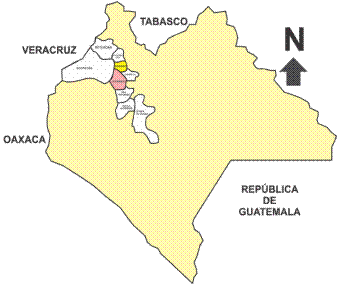
Figure 1 Location of the study area. Source: from the municipal division in the state of Chiapas processing.
The interaction of the strategies was analyzed with other subsystems, as well as the use, availability and dynamics of them and support programs of the federal and state government were added. About such concepts are incorporated: dawn stimulus program for people aged 60 and over state government of Chiapas; seventy more; program of support for elderly people of the federal government; opportunities: support program for mothers and children school age. corn solidarity; program consistent support in improved inputs in corn, bio-fertilizer, herbicides and 100 kilograms of fertilizer, PROCAMPO; PROGAN, which are programs supporting the field and livestock federal government, solidarity Chiapas, support for micro, small, medium and large enterprises, CODECOA, state government program that involves the delivery of basic tools and small producers, PESA, Strategic Programme for Food Security FAO-SAGARPA.
Results and discussion
Producers and their families in both municipalities, have a production system based on polyculture centered maize, Zea mays (L). In Mexico it has been called "milpa" which revolves around the native maize associated with beans of the species Phaseolus spp. and Coccineus spp., also squash Cucurbita pepo and sometimes with chayote Sechium edule Jacq. Merill, fences or trees in the periphery. It is complemented with pepper cultivars Pimenta dioica (L.) Merrill, and coffee Coffea arabica (L.), under rainfed conditions and slopes greater than 60%, although there are lands with slopes of 30%. Above 1 500 meters above sea level can be seen in the backyard trees peach Prunus persica (L.) and avocado criollo or "chinini" Persea spp.
Based on the approach to production systems described by Hart (1985), they are conceptualized systems as an array or set of linked physical components or related acting as a unit or a whole, each set that composes it behaves like a complete entity. Spedding (1979) defines agricultural production systems as inputs input and output of agricultural products of biological origin. However, to understand a system is necessary to disaggregate production parts and study them one by one, with the help of various disciplines, so that in the end a greater understanding of the production system will have. Spedding (1979); Tripp (1990); Hart (1985); Pontie (1992).
In that sense Pontie (1992) from the agricultural perspective, conceptualizes production systems as structured set of agricultural and livestock productions are held by farmers in their production unit to achieve its objectives, Pontie unlike authors above and for the social approach enriches the definition by including peasants or farmers as operators and beneficiaries. A little later Borlaug and Enkerlin (1997) restate this definition and also include the human factor, concluding that an agricultural production system is a set of practices including technology and human resources, and through these elements is achieved agricultural production. This vision of the family unit or production unit is largely enriched by the concepts of those who make the peasant family and the characteristics of the household or peasant unity and the factors that contribute to strengthen the rural economy and strategies of persistence or survival, dumped by Chayanov (1974); Wolf (1975) and subsequently taken up by Martinez (1987) and Galesky (1997).
Thus, a picture of how are relations in both municipalities, which were analyzed together in sight. While there are differences between the two municipalities, the trend of sales and income are very similar. Figure 2, you can see the four distinct subsystems: 1) agricultural having crops monoculture corn, corn associated with beans, squash, these last three encompassed in the "milpa" system, besides other species like pepper , coffee and some cocoa plants, also mention the chayote as a vegetable consumption and sometimes for sale; 2) the livestock where some producers dairy cows whose production is four liters per day that when required cheese for sale is made, the average is 3.14 cattle and 2.14 birds per head of household; 3) subsystem basically forest pine Pinus spp. and "acahual" or scrub several years which is used for grazing when producers have won and finally; and 4) the subsystem of the family unit which highlights the characteristics of producers and their families, whether nuclear or extended.
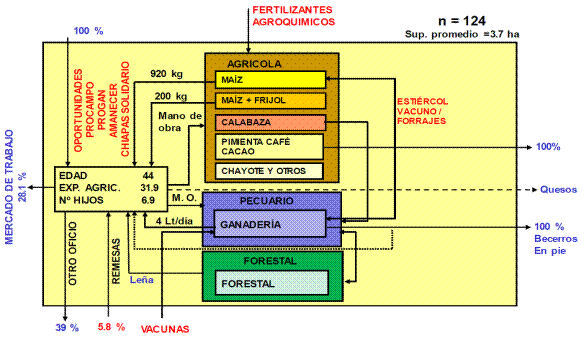
Figure 2 Interactions between subsystems of households in the municipalities of Copainala and Ocotepec, Chiapas (n= 124).
The average age of farmers is 44 years old experience as a farmer about 32 years. They also have on average 6.9 children, which for some indicators represent the peasant household labor force (Figure 2). However, these upon reaching 15 years of age migrate to the main labor market mentioned in Figure 7. These data are consistent with those reported by Magdaleno et al. (2014) who made his studio in the center of the country and found that one of the alternatives peasant survival is internal migration.
On the other hand and although it was not found in this study Aguirre (2013) indicated that farmers in central Veracruz addition to their primary activity are selling products to increase their income and take into account the sale of ecotourism services as an alternative persistence without them are considered as micro or small entrepreneurs. Meanwhile, Rojas et al. (2014) note in their study in the villages pooled the Sierra Juarez of Oaxaca, the peasants refuse to work as processors and employees in logging operations and for them strategies persistence are based solely on the management and exploitation of the forest contrary to what happens in other regions with high rates of marginalization. This makes sense from the point of view of the prevailing community and social strategies such as mutual assistance in religious and private acts as the "guelaguetza" and "tequio" for community work for the benefit of the population. Tome et al. (2014) found that strategies of peasant persistence in a study in Puebla were strengthened by the proximity to the industrial centers in the state, and although they were forced to leave employment temporarily or permanently returned to agricultural activities, these authors conclude that the peasants went from being an agricultural society to an industrial-commercial society, indirect employment and involvement of most of the economically active population (PEA) that replaced agricultural work income for their labor or specialization in a trade.
According to the studies of the new widely described rurality by (IICA, 1999; IICA, 2000, de Llambi, 2000; Guzman, 2000; Souza and Cheaz, 2001 and retaken by Cadena (2004) and Cadena et al. (2013), not only should be considered for the family economy agricultural activities, 39% of producers in the municipalities of Copainala and Ocotepec, besides being farmers have another trade or are craftsmen. they also receive remittances from relatives in other places without specified if it is in national territory or in the United States. they also receive both producers and their families a number of government support among which are opportunities, PROCAMPO, PROGAN, solidarity Chiapas, corn solidary, kilo aid, dawn, seventy more CODECOA, among others, as shown in Figure 3.
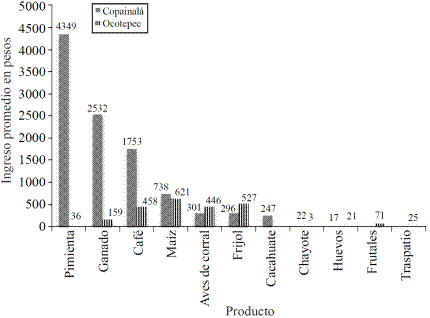
Figure 3 Average income by type of government support ($) in the municipalities of Copainala (n= 61) and Ocotepec (n= 63), Chiapas. Source: from field work processing.
In Figure 4 is a considerable difference between the two municipalities by the level of income from sales of surplus agricultural products once satisfied their caloric requirements, while there is greater income from sale of livestock and products of industrial perennials such as coffee and pepper is clear that in Ocotepec, families have less income for the same activity. On the other hand the support they receive from federal programs and state governments have great significant for the reproduction of the family unit.
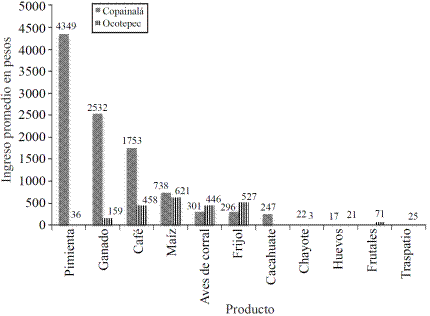
Figure 4 Average Revenue from sales of commodities ($) in the municipalities of Copainala (n= 61) and Ocotepec (n= 63), Chiapas. Source: from field work processing.
Aguirre (2013) in a conceptual theoretical analysis indicated that the peasant persistence is evident due to the flexibility of production to the ravages of the market and society in general. Such flexibility allows the farmer production system readjust to the different situations of market dynamics is determined by its operation based on the use of family labor. However, it is clear that did not take in its analysis revenues of government support and other nongovernmental organizations, however in contrast to what was found in the municipalities of Ocotepec and Copainala producers if they have relaxed their productive activities with the sole purpose to have food security for themselves and their families. It is noteworthy that such support revenues are more important than those obtained by the sale of commodities, and the trend remains the same in both municipalities, higher revenues and lower Copainala in Ocotepec, Garrido (2012).
However to have and maintain their production levels that enable producers to reproduce their family unit, the seasonal activity of agricultural activities, which producers have any job other than being a farmer and a number of children(as) that can contribute resources to sustain the family unit makes a high percentage leave the community to the labor market, one of the most frequent the county seat, where the most frequent job is to journeyman, while for other destinations the most appropriate is the mason trade and industry of tourism services and food (Figure 5).
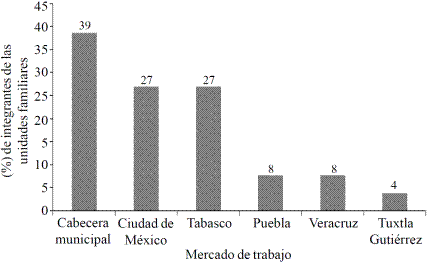
Figure 5 Percentage of members of households who leave the labor market from the municipalities of Copainala and Ocotepec, Chiapas (n= 35). Source: from field work processing.
Carton de Grammont cited by Figueroa (2005), specifically indicated for this type of subcontracting between producers or farmers (SIC) does not transform farmers into entrepreneurs or proletarians who live on that salary, rather are forms of mutual self-help in the agricultural field.
While it is true that production levels do not decrease but in some cases increase slightly as a result of the intervention, it is true that these are not attractive enough to prevent migration of households, however why should we assume that projects, programs and interventions in order to improve the living conditions of people living in marginal conditions have to "stay" in their hometowns? Not a very selfish vision think of denying them equal opportunities for people to enjoy these advances and technological developments -if they want-before thinking that if production surplus product of the intervention were to be achieved "anchor "a productive unit?
One thing is sure that with government support the producers of these communities expect the support to which they are entitled and that by simply being registered must receive it, is no reason for this document, the final destination is given to those resources, but one thing is certain, is not invested in the production unit, rather it is used to purchase goods, clothing and food not produced in the household, especially those who are not in kind.
Conclusions
Although Copainalá and Ocotepec are neighboring municipalities, there is a difference between them in economic and competitive terms, the production is carried out in Copainalá reaches a salvageable sales that bring the family money income, however, in the towns of Ocotepec, the most families produce for their own consumption.
The interrelationships with consumer centers generates a greater variety of trades and survival strategies promoting a better balance between monetary income and consumption.
One aspect that may generate risks of vulnerability is economic dependence on government programs such as PROCAMPO, PROGAN, OPPORTUNITIES, or DAWN, which as shown, can exceed revenue of production itself. The financial support given by the government is no factor to ensure the welfare or economic growth of the family because they are not given track and producers do not invest the money earned in their production, because it shows that production costs will not they are not a third of the money the government gives them.
Literatura citada
Aguirre, C. J. F. 2013. Persistencia de producción campesina con base en el conocimiento local: el sistema cafetalero de Veracruz, México. Tesis de maestría en Ciencias. Colegio de Postgraduados. Cholula Puebla, México. 182 p [ Links ]
Boltvinik, J. 2012. Pobreza y persistencia del campesinado. Teoría, revisión bibliográfica y debate internacional. Mundo Siglo XXI. Revista del CIECAS. 28(8):19-39. [ Links ]
Cadena, I. P. 2004. Actores, estrategias y dinámicas de organización en el agro de La Frailesca, Chiapas. Tesis doctor en ciencias. Colegio de Postgraduados. Montecillos, Estado de México. 188 p. [ Links ]
Cadena, I. P.; Camas, G. R.; López, B. W. y Navarro, G. H. 2013. Implicaciones prácticas y teóricas de la nueva ruralidad en la Frailesca, Chiapas, México. Rev. Mex. Cienc. Agríc. 4(7):1013-1026. [ Links ]
CONEVAL. 2011. Cada día, 4 mil 452 nuevos indigentes. In: la razón México. [ Links ]
Chayanov, A. 1974. La organización de la unidad doméstica campesina. Buenos Aires, Argentina. Ediciones Nueva Visión. [ Links ]
Figueroa, M. V. 2005. América Latina; descomposición y persistencia de lo campesino. Rev. Latinoam. Econ. 36(142) 27-50. [ Links ]
Galeski, B. 1997. Sociología del campesinado. Barcelona. Editorial Península. 133-162 pp. [ Links ]
Garrido, L. K. I. 2012. Determinación del impacto socioeconómico de los programas de apoyo gubernamentales en el sector productivo rural en la región sur sureste de México; caso Ocotepec y Copainalá, Chiapas. Tesis maestría en Ciencias. Universidad Autónoma de Chiapas. Tuxtla Gutiérrez, Chiapas, México 123 p. [ Links ]
Guzmán, M. Ma. A. 2000. Organizaciones campesinas y su sistema de representación. Estudios Agrarios. 6(15):203-249. [ Links ]
Instituto Interamericano de Cooperación para la Agricultura (IICA) 1999. Nueva ruralidad. Dirección de Desarrollo Rural Sostenible. San José, Costa Rica. 50 p. [ Links ]
IICA. 2000. Nueva Ruralidad. Dirección de Desarrollo Rural Sostenible. San José, Costa Rica. (2000-01). 30 p. [ Links ]
Llambí-De, L. 2000. La nueva ruralidad en América Latina. Pontificia Universidad Javeriana. Instituto Venezolano de Investigaciones Científicas (IVIC). Seminario Internacional “La Nueva Ruralidad en América Latina” 22-24 de marzo de 2002, Bogotá, Colombia. 24 p. [ Links ]
Magdaleno, H. E; Jiménez, V. M.; Martínez, S. T. y Cruz, G. B. 2014. Estrategias de las familias campesinas en Pueblo Nuevo, municipio de Acambay, Estado de México. Agric. Soc. Des. 11(2):167-179. [ Links ]
Martínez, S. T. 1987. Campesinado y política: movimientos o movilizaciones campesinos. In: Glantz, S. (Comp.). La heterodoxia recuperada en torno a Ángel Palerm. México. Fondo de Cultura Económica. 3-31 pp. [ Links ]
Palacios, A. 2007. Diferencias, limitaciones y alcances de las estrategias de combate a la pobreza en México. In: la política social en México: tendencias y perspectivas. Cordera, R. y Cabrera, C. (Coord.). Facultad de Economía. UNAM. México. 116 p. [ Links ]
Rojas, S. C.; Martínez, C. B.; Vázquez, G. V.; Castañeda, S., P; Zapata, M. E. y Sámano, R. M. A. 2014. Estrategias de reproducción campesina, género y valoración del bosque en Lachatao, Oaxaca, México. Rev. Agric. Soc. Des. 11(1):71-92. [ Links ]
Souza, S. J. de y Cheaz, J. 2001. La dimensión institucional del desarrollo sostenible; de las reglas de vulnerabilidad a las premisas de la sostenibilidad en el contexto de cambio de época. Servicio Internacional para la Investigación Agrícola Nacional (ISNAR). San José, Costa Rica. 106 p. [ Links ]
Tomé, H. G.; Méndez, E. J. A.; Pérez, R. N.; Ramírez, J. J. y Tornero, C. M. A. 2014. Estrategias de reproducción familiar en Santa María Moyotzingo, Puebla, México. Rev.Agric. Soc. Des. 1(11):93-111. [ Links ]
Wolf, E. 1975. Los campesinos. Editorial Labor. Barcelona, España. Editorial Labor. 150 p. [ Links ]
Borlaug, N.E. y Enkerlin, H.E.C. 1997. Agricultura y alimentación. In: Ciencia Ambiental y Desarrollo Sostenible. Thompson Editores. México, D. F. 291 p. [ Links ]
Hart, R. D. 1985. Agroecosistemas; conceptos básicos. Centro Agronómico Tropical de Investigación y Enseñanza. Turrialba, Costa Rica. 159 p. [ Links ]
Pontie, G. 1992. Sistema de producción. ¿Concepto o lugar de encuentro? El punto de vista de un sociólogo. In: Memorias del coloquio mesoamericano de sistemas de producción y desarrollo agrícola. Colegio de Postgraduados, CONACYT, ORSTOM, Montecillo, Estado de México. 83-88 pp. [ Links ]
Spedding, C. R. W. 1979. Ecología de los sistemas agrícolas. Blume, H. (Ed.). Madrid, España. 60 p. [ Links ]
Tripp, R. 1990. Farming system research revisited. In: Agricultural development in the third world. Second Edition. The Johns Hopkins University Press. U. S. A. 264-274 pp. [ Links ]
Received: February 2016; Accepted: May 2016











 texto em
texto em 


